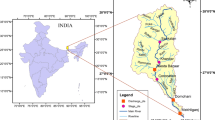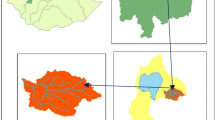Abstract
The Sindh Valley watershed is one of the most important water resources of Jammu and Kashmir, India. It is the largest tributary of the Jhelum River in the valley of Kashmir. It contributes prominent share to the economy of the state, through generation of hydroelectricity and irrigation for agriculture. Therefore, in the present study, the Sindh Valley watershed flows were assessed using a hydrological model, i.e., Hydrologic Engineering Centre–Hydrological Modeling System (HEC-HMS). The four components of HEC-HMS, i.e., basin model, meteorological model, control specification, and input times series were set up and linked together for simulating the discharge. The model was calibrated for the period between 2001 and 2017 for the three gauging sites, i.e., Dudarhama, Narayanbagh, and Preng of the drainage stream of the Sindh Valley watershed, commonly known as River Sindh. After the successful calibration, model validation was done for the period between 1992 and 2000. The performance indicators, i.e., coefficient of determination, percent deviation and Nash–Sutcliffe efficiency were calculated for statistical analysis of observed and simulated discharge. The R2 and E values ranged between 0.85–0.88 and 0.79–0.86 at different gauging stations of the watershed. Values of D stretching from −10.89 to −11.73 and 6.38 to 8.12 for calibration and validation period, respectively, indicated that the model overestimated during validation period and underestimated during the calibration period. The satisfactory values of the performance indicators showed that the hydrological model results can be accepted for the simulation of the discharge of Sindh Valley watershed.






Similar content being viewed by others
References
Agarwal CS, Garg PK (2002) Textbook on remote sensing: in natural resources monitoring and management. A H Wheeler Publishing Co Ltd, Allahabad, India
Belayneh A, Sintayehu G, Gedam K, Gedam K, Muluken T (2020) Evaluation of satellite precipitation products using HEC-HMS model. Model Earth Syst Environ 6:2015–2032. https://doi.org/10.1007/s40808-020-00792-z
Bhatt JR, Sharma SK (2002) Impacts of climate change on India and climate change related activities. In: Shukla PR, Sharma SK, Subodh K, Ramana PV (eds) Climate change and India: issues, concerns and opportunities. Tata McGraw-Hill Publishing Company Ltd, New Delhi, India
Brunner MI, Farinotti D, Zekollari H, Huss M, Zappa M (2019) Future shifts in extreme flow regimes in Alpine regions. Hydrol Earth Syst Sci 23:4471–4489. https://doi.org/10.5194/hess-23-4471-2019
Chu J, Xia J, Xu CY, Singh V (2010) Statistical downscaling of daily mean temperature, pan evaporation and precipitation for climate change scenarios in Haihe River. China Theor Appl Climatol 99:149–161. https://doi.org/10.1007/s00704-009-0129-6
IPCC, Climate Change (2013) The physical science basis; contribution of working group I to the fifth assessment report of the inter-government-mental panel on climate change. Cambridge University Press, Cambridge, UK; New York, NY, USA, p 1535
Icyimpaye G, Abdelbaki C, Mourad KA (2021) Hydrological and hydraulic model for flood forecasting in Rwanda. Model Earth Syst Environ. https://doi.org/10.1007/s40808-021-01146-z
IPCC. Climate Change (2007) The Physical Science Basis; Solomon, S., Qin, D., Manning, M., Chen, Z., Marquis, M., Averyt, K.B., Tignor, M., Miller, H.L., Eds.; Contribution of Working Group I to the Fourth Assessment Report of the Intergovernmental Panel on Climate Change; Cambridge University Press: Cambridge, UK, 2007
Jasrotia A, Baru D, Kour R, Ahmad S, Kour K (2021) Hydrological modeling to simulate stream flow under changing climate conditions in Jhelum catchment, western Himalaya. J Hydrol 593:125887. https://doi.org/10.1016/j.jhydrol.2020.125887
Khattak MS, Babel MS, Sharif M (2011) Hydro-meteorological trends in the Upper Indus River basin in Pakistan. Clim Res 46:103–119. https://doi.org/10.3354/cr00957
Koneti S, Sunkara SL, Roy PS (2018) Hydrological modeling with respect to impact of land-use and land-cover change on the runoff dynamics in Godavari river basin using the HEC-HMS model. ISPRS Int J Geo Infor 7(6):206. https://doi.org/10.3390/ijgi7060206
Lin F, Chen X, Yao H (2017) Evaluating the use of nash-sutcliffe efficiency coefficient in goodness-of-fit measures for daily runoff simulation with SWAT. J Hydro Engg. https://doi.org/10.1061/(ASCE)HE.1943-5584.0001580
Mahmood R, Jia S (2016) Assessment of impacts of climate change on the water resources of the transboundary Jhelum River Basin of Pakistan and India. Water 8(6):2073–4441. https://doi.org/10.3390/w8060246
Malik M, Dar AQ, Jain MK (2021) Modelling streamflow using the SWAT model and multi-site calibration utilizing SUFI-2 of SWAT-CUP model for high altitude catchments NW Himalaya’s. Model Earth Syst Environ. https://doi.org/10.1007/s40808-021-01145-0
Meenu R, Rehana S, Mujumdar PP (2013) Assessment of hydrologic impacts of climate change in Tunga-Bhadra River basin, India with HEC-HMS and SDSM. Hydrol pro 27:1572–1589. https://doi.org/10.1002/hyp.9220
Middelkoop H, Daamen K, Gellens D, Grabs W, Kwadijk JC, Lang H, Parmet BW, Schadler B, Schulla J, Wilke K (2001) Impact of climate change on hydrological regimes and water resources management in the Rhine basin. Clim Change 49:105–128
Parvaze S, Khan J, Kumar R, Allaie S (2021) Temporal flood forecasting for trans-boundary Jhelum River of Greater Himalayas. Theo Appl Climato. https://doi.org/10.1007/s00704-021-03562-8
Roy D, Begam S, Ghosh S, Jana S (2013) Calibration and validation of HEC-HMS model for a river basin in eastern India. ARPN J Engg Appl Sci 8(1819–6608):40–56
Shrestha M, Koike T, Hirabayashi Y, Xue Y, Wang L, Rasul G, Ahmad B (2015) Integrated simulation of snow and glacier melt in water and energy balance-based, distributed hydrological modeling framework at Hunza River basin of Pakistan Karakoram region. J Geophys Res Atmos 120.
Singh D, Gupta RD, Jain S (2015) Assessment of impact of climate change on water resources in a Hilly River basin. Arab J Geosci 8:10625–10646. https://doi.org/10.1007/s12517-015-1985-2
Van Liew MW, Garbrecht J (2003) Hydrologic simulation of the little Washita river experimental watershed using swat1. J Am Water Resour Assoc 39:413–426. https://doi.org/10.1111/j.1752-1688.2003.tb04395.x
Verma A, Jha M, Mahana R (2010) Evaluation of HEC-HMS and WEPP for simulating watershed runoff using remote sensing and geographical information system. Paddy Water Environ 8:131–144. https://doi.org/10.1007/s10333-009-0192-8
Wang H, Zhang M, Zhu H, Dang X, Yang Z, Yin L (2012) Hydro-climatic trends in the last 50 years in the lower reach of the Shiyang River basin, NW China. CATENA 95:33–41. https://doi.org/10.1016/j.catena.2012.03.003
Zhang XC, Liu WZ, Li Z, Chen J (2011) Trend and uncertainty analysis of simulated climate change impacts with multiple GCMS and emission scenarios. Agric for Meteorol 151:1297–1304. https://doi.org/10.1016/j.agrformet.2011.05.010
Author information
Authors and Affiliations
Corresponding author
Additional information
Publisher's Note
Springer Nature remains neutral with regard to jurisdictional claims in published maps and institutional affiliations.
Rights and permissions
About this article
Cite this article
Shah, M., Lone, M.A. Hydrological modeling to simulate stream flow in the Sindh Valley watershed, northwest Himalayas . Model. Earth Syst. Environ. 8, 2461–2470 (2022). https://doi.org/10.1007/s40808-021-01241-1
Received:
Accepted:
Published:
Issue Date:
DOI: https://doi.org/10.1007/s40808-021-01241-1




